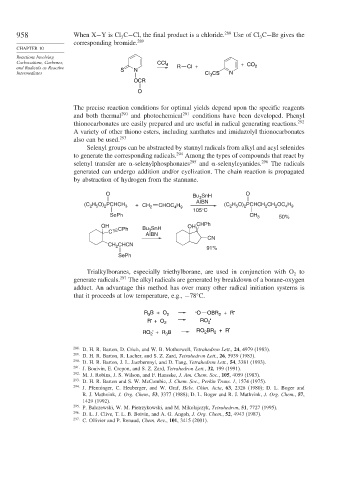Page 982 - Advanced Organic Chemistry Part B - Reactions & Synthesis
P. 982
958 When X−YisCl C−Cl, the final product is a chloride. 288 Use of Cl C−Br gives the
3
3
corresponding bromide. 289
CHAPTER 10
Reactions Involving
Carbocations, Carbenes, CCl 4 + CO
and Radicals as Reactive S N R Cl + 2
Intermediates Cl CS N
3
OCR
O
The precise reaction conditions for optimal yields depend upon the specific reagents
and both thermal 290 and photochemical 291 conditions have been developed. Phenyl
thionocarbonates are easily prepared and are useful in radical generating reactions. 292
A variety of other thiono esters, including xanthates and imidazolyl thionocarbonates
also can be used. 293
Selenyl groups can be abstracted by stannyl radicals from alkyl and acyl selenides
to generate the corresponding radicals. 294 Among the types of compounds that react by
selenyl transfer are -selenylphosphonates 295 and -selenylcyanides. 296 The radicals
generated can undergo addition and/or cyclization. The chain reaction is propagated
by abstraction of hydrogen from the stannane.
O O
Bu SnH
3
AIBN
(C H O) PCHCH 3 + CH 2 CHOC H (C H O) PCHCH CH OC H
2
2 5
2
4 9
2
2 5
2
4 9
105°C
SePh CH 3 50%
OH CPh Bu SnH OH CHPh
C 3
AIBN
CN
CH CHCN 91%
2
SePh
Trialkylboranes, especially triethylborane, are used in conjunction with O to
2
generate radicals. 297 The alkyl radicals are generated by breakdown of a borane-oxygen
adduct. An advantage this method has over many other radical initiation systems is
that it proceeds at low temperature, e.g., −78 C.
R 3 B + O 2 . O OBR + R .
2
. .
R + O 2 RO 2
. RO BR + R .
RO + R B 2 2
3
2
288 D. H. R. Barton, D. Crich, and W. B. Motherwell, Tetrahedron Lett., 24, 4979 (1983).
289
D. H. R. Barton, R. Lacher, and S. Z. Zard, Tetrahedron Lett., 26, 5939 (1983).
290 D. H. R. Barton, J. L. Jaszberenyi, and D. Tang, Tetrahedron Lett., 54, 3381 (1993).
291 J. Bouivin, E. Crepon, and S. Z. Zard, Tetrahedron Lett., 32, 199 (1991).
292
M. J. Robins, J. S. Wilson, and F. Hansske, J. Am. Chem. Soc., 105, 4059 (1983).
293 D. H. R. Barton and S. W. McCombie, J. Chem. Soc., Perkin Trans. 1, 1574 (1975).
294
J. Pfenninger, C. Heuberger, and W. Graf, Helv. Chim. Acta, 63, 2328 (1980); D. L. Boger and
R. J. Mathvink, J. Org. Chem., 53, 3377 (1988); D. L. Boger and R. J. Mathvink, J. Org. Chem., 57,
1429 (1992).
295 P. Balczewski, W. M. Pietrzykowski, and M. Mikolajczyk, Tetrahedron, 51, 7727 (1995).
296 D. L. J. Clive, T. L. B. Boivin, and A. G. Angoh, J. Org. Chem., 52, 4943 (1987).
297
C. Ollivier and P. Renaud, Chem. Rev., 101, 3415 (2001).

